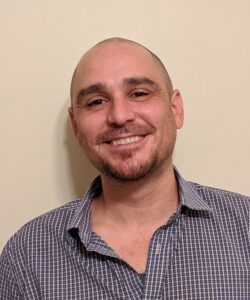
Thoughts From a Wounded Healer
by Jesse Jonesberg
The Wounded Healer
Jung coined the term “wounded healer” to describe healers who are motivated to support others due to their own personal experiences of suffering and trauma (1968). Through life experiences, the wounded healer develops a deep sense of understanding and compassion for fellow humans on their recovery and healing paths. When used skillfully, this extraordinary compassion is a superpower that helps mental health professionals connect with and support others in mental distress. However, the compassion of the wounded healer can also serve as kryptonite if used indiscriminately, leading to overwhelm, limbic transference, and ultimately damaging the therapeutic partnership (Mehta, 2024; Grand, 2013). Due to the perceived dangers of self-disclosure and mental health stigma, wounded healers have long been covert. Therapists have largely hidden their experiences with mental health, both in the therapy room and among clinical colleagues.
There has long been a taboo against the explicit use of the wounded healer’s superpowers among therapists. Self-disclosure is completely discouraged in many psychoanalytic approaches, while humanistic therapies have sometimes allowed it (Hill et al., 2001). But this is slowly changing. The peer support approach in mental health, which emphasizes sharing stories to support others, has proven helpful for individuals in recovery (White et al., 2020). Today, in professional therapy circles, using self-disclosure to help others is becoming more mainstream (Warrender, 2020). Some researchers are even proposing the adoption of self-disclosure as a formal therapeutic intervention (Ziv-Beiman, 2013). The latest edition of the Motivational Interviewing textbook now emphasizes the importance of therapists’ genuineness and authenticity (Miller & Rollnick, 2023). I think that, as a profession and as a society, we are moving toward transparency about our suffering, mental health, and general human messiness.
My Experience as a Wounded Healer
As a therapist who has always struggled with my own mental health, I identify with Jung’s idea of the wounded healer. My experiences with trauma, mental health struggles, and social exclusion motivate me to serve others with similar life experiences. These experiences have shaped my worldview and informed how I developed in the world around me from a very young age. This gives me insight and skills in connecting with and supporting others in suffering and hopelessness. I use my past (or present) experiences as fertile ground to grow empathy with another person, and this skill comes quite naturally to me. Reflecting on my employment history over the past few decades, I can confidently say that the role of a wounded healer in community mental health has been the perfect fit for my skills, talents, and aspirations in life.
Helping others as a therapist, caseworker, or other mental health professional is life-changing. I have witnessed miraculous recoveries among those I serve, and I have also witnessed some of the most heartbreaking moments of suffering. In all this work, the beauty of humanity shines through. It inspires me to embrace my own imperfections and innate human messiness. As a therapist, I use the anger, pain, and sadness I carry as fuel. I can transmute these emotions into compassion. If I am skillful, others will heal. If I make a mistake in relating to a client (and I definitely have), I can apologize and recenter myself. I draw upon my experiences with mental health like selecting a crayon. Self-disclosure is one of the colors in the therapy crayon box shared by the client and me. Sometimes we may use my favorite hues of teal and red-orange; other times, we may create art in muted greyscale.
Self-Disclosure in Social Work and Therapy
I see self-disclosure as one of many tools that could be helpful or unhelpful, depending on the situation. The National Association of Social Workers (NASW) reminds social workers to be very intentional and careful when using self-disclosure to help a client (2001). For example, after obtaining client permission, I might say, “When my thoughts spiral like you just described, I notice changes in my heartbeat, breathing, restlessness, etc. What is it like in your body when the thought spiral comes up?” This could support the client in developing awareness of anxiety symptoms in the body and model the skill of mindfulness of bodily sensations.
On the other hand, if I were to say, “I’ve had a really hard time staying focused lately; my ADHD symptoms are acting up, and my mind keeps wandering when people talk for more than five minutes,” it could damage the therapeutic alliance. The client might feel like a burden, and it could lead to a role reversal in the therapist-client relationship. In social work, we are always told to ask ourselves, “Whose needs are being met here?” when using self-disclosure (Reamer, 2006). I think this is good advice. Self-disclosure can humanize the therapist, create a strong connection, and make sessions feel more natural. We might make mistakes when using this skill, but mistakes happen with any skill. When we make mistakes, we apologize and repair.
Just the other day, a new client asked in an astonished tone, “Did you just say that you also have ADHD?!” Initially, I felt a surge of anxiety and self-consciousness. Did I make a mistake? Was that too much information, too early, or too personal? Was it self-serving?
After a pause, the client continued, “You mean to tell me that you are neurodivergent? I’ve never had a therapist or any other professional tell me that… This is beautiful; it tells me that I’m in the right place, that you would share that with me, and that you understand some of this stuff.” After hearing how they processed this information, I felt relieved. I was happy to know that this particular disclosure was helpful and not harmful in that context.
Common Humanity
Kristin Neff and Chris Germer have identified common humanity as one of the three key principles in Mindful Self-Compassion (2020). For me, the principle of common humanity is my guiding light in the fog of therapy. I trust that the client and I are two humans, sitting together, sharing space and time in our shared humanity. It’s important to set the intention of helping the client heal, hold them with compassion, and collaborate in selecting our therapeutic palette. Through all this, I stay attuned to myself, the client, and the relationship.
As a wounded healer, I draw on personal experiences with mental health to build connection, compassion, and community. As a professional, I have been trained in skills and theories that can help along the way. When I integrate my professional training and life experiences in mental health, I show up as my best self for the sake of helping fellow travelers on the path to recovery and healing.
SOURCES:
Hill, C. E., & Knox, S. (2001). Self-disclosure. Psychotherapy: Theory, Research, Practice, Training, 38(4), 413.
Jung CG. (1968) The Archetypes and the Collective Unconscious. Princeton University Press
Miller, W. R., & Rollnick, S. (2023). Motivational interviewing: helping people change and grow. Fourth edition.
Mehta, D.H. (2024). Nurturing Resilience in the Wounded Healer. Psychiatric Times. Retrieved from: https://www.psychiatrictimes.com/view/nurturing-resilience-in-the-wounded-healer
National Association of Social Workers (NASW). (2021). National Association of Social Workers Code of Ethics. Retrieved from: https://www.socialworkers.org/...
Neff, K. & Germer, C. (2020). The transformative effects of mindful self-compassion. Mindful Magazine. Retrieved from: https://mindfulwerkenmetcompassie.nl/wp-content/uploads/2020/03/The-Transformative-Effects-of-Mindful-Self-Compassion-Neff-Germer.pdf
Reamer, F.G., (2006), Self-Disclosure in Clinical Social Work. Social Work Today. Retrieved from: https://www.socialworktoday.com/news/eoe_1106.shtml
Warrender, D. (2020). Self-disclosure: the invaluable grey area. British journal of mental health nursing, 9(1), 9-15.
White, S., Foster, R., Marks, J., Morshead, R., Goldsmith, L., Barlow, S., ... & Gillard, S. (2020). The effectiveness of one-to-one peer support in mental health services: a systematic review and meta-analysis. BMC psychiatry, 20, 1-20.
Victor, S. E., Devendorf, A. R., Lewis, S. P., Rottenberg, J., Muehlenkamp, J. J., Stage, D. L., & Miller, R. H. (2022). Only Human: Mental-Health Difficulties Among Clinical, Counseling, and School Psychology Faculty and Trainees. Perspectives on Psychological Science, 17(6), 1576-1590. https://doi.org/10.1177/174569...
Ziv-Beiman, S. (2013). Therapist self-disclosure as an integrative intervention. Journal of Psychotherapy Integration, 23(1), 59.
